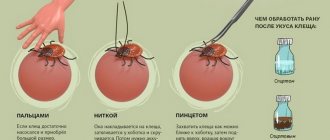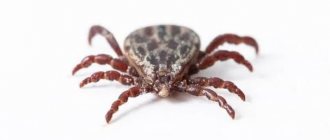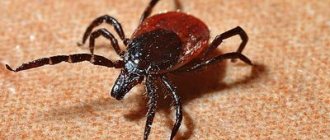Many people think that ticks can only bite a person or a dog, without posing a danger to the cat family. This is not true; according to statistics, cats suffer from tick bites and develop complications much less frequently, but the course of the disease, diagnosis and treatment are more difficult. Even domestic cats require special attention, since the parasite can enter the house through shoes or on human clothing.
Ticks are especially active from March to November; they can be found in grass or bushes, in city parks, and forests. Parasites pose a danger to walking animals, but even if the animal does not leave the house or apartment, the risk of finding a parasite in a cat is not so small.
General information about ticks that parasitize cats
Between the end of May and the beginning of July, all warm-blooded animals are at risk of being attacked by dangerous parasites, an encounter with which can lead to dire consequences. This threat also applies to cats.
At this time, mites are activated - representatives of the class of arachnids, a subclass of arthropods. To date, more than 50 thousand species of these bloodsucking creatures have been described. Three main types of ticks pose a particular danger to cats:
- ixodid;
- ear;
- subcutaneous.
Ixodid ticks live and lie in wait for their victims in grass and low bushes. Even a domestic cat can be bitten by a bloodsucker. Therefore, after a walk around the garden or on the lawn, the animal must be carefully examined. A detected tick should be immediately removed and destroyed.
Ixodid ticks prefer to attach themselves in places that are difficult for the animal to reach - on the back, stomach, joint bends, and armpits. The skin there is more tender, and the cat will not be able to reach it.
Owners' fears that a cat may die from a tick bite are not unfounded. The parasite's saliva can transmit pathogens of dangerous diseases. Also, the condition of a bitten cat can be complicated by a secondary infection.
Ear mites, despite their small size (smaller than a grain of semolina), can cause great trouble not only for a cat, but also for other pets. It is easy to become infected by contact with a carrier, but curing a cat from this scourge is not so easy.
Subcutaneous mites are no less dangerous. They choose the upper layers of the cat's skin as their habitat and become the cause of its suffering. Ticks gnaw passages in the skin and feed on the tissues and blood of the animal, which causes unbearable itching.
Small kittens and cats over 7 years old are especially defenseless against tick attacks and the consequences of their pathological influence.
It does not matter what type of mites the cat is infected with. The first task when an infestation is detected is to get rid of the parasite and immediately begin adequate treatment.
What types of blood-sucking ticks can threaten cats?
All blood-sucking ticks, also called ixodid ticks, or ticks, pose a threat to cats. The most common types of ticks found in Russia are:
- Ixodes ricinus;
- Rhipicephalus sanguineus;
- Dermacentor reticulatus.
A cat can be bitten by any other ixodid tick - there is no fundamental difference in this.
Photo gallery: the most common types of ticks
The Ixodes ricinus tick is the most common type of bloodsucker.
The tick of the species Rhipicephalus sanguineus is the most common representative of this family in Russia
The mite Dermacentor reticalatus is a typical inhabitant of deciduous and mixed forests in Europe and Siberia
All these ticks have common properties: they necessarily feed on blood. Both adult, mature ticks and their larvae - nymphs - attack.
Typically, female ticks are found on animals - they need a lot of blood to reproduce, so they can remain at the site of the bite for up to several days. Nymphs and males need less blood, and often they leave the bite site on their own and unnoticed, thereby infecting the cat.
Ticks usually hide in grass, bushes, and low vegetation. They are found everywhere - from city courtyards and squares to fields and forests. Even if the cat does not leave the house, there remains a risk of being attacked by a tick brought into the apartment by people or other animals (usually a dog), as well as along with mushrooms collected in the forest, a wreath woven in a field, or greens collected at the dacha.
Ticks become active at air temperatures above +8 °C; their peak activity occurs in spring and autumn. But the possibility of a bite cannot be ruled out even in winter, for example, near a heating main or during a thaw on a thawed lawn.
The good news is that not all ticks are contagious. The range and frequency of diseases transmitted by ticks differ in different regions, and the most comprehensive information on a specific area can be obtained from the regional sanitary and epidemiological surveillance service.
Ixodidae
The Ixodid tick is the most common type of parasite and the largest. It has an oval body, which is covered with a chitinous shell, 8 legs and a disproportionately small head. The carapace covers about one third of the insect's body, which allows the elastic abdomen to expand 3 times when filled with the blood of the attacked animal. The main weapon of a tick is its proboscis with hooks (similar to fishing hooks), which allow it to gain a foothold in the body of the victim. Ticks remain on the animal from several days to 1 month.
At the moment of the bite, the tick injects a secret agent under the skin - saliva, which has an anesthetic effect. Therefore, the cat does not feel when ticks bite her, and gives the parasites time to securely attach themselves to the skin. After this, the tick on the cat begins to eat - it gains access to small blood vessels and sucks blood.
The flat black or dark brown body of the insect swells as it becomes saturated and looks like a large bead. The color also changes - from pinkish-gray to red and brown.
After satiation, the male tick detaches and goes to rest in a secluded place, and the female lays eggs in the wound and dies.
How to remove a stuck tick
The longer the embedded tick remains on the cat, the higher the likelihood of transmitting to it an infectious dose of the pathogen sufficient to initiate the disease. The bloodsucker needs to be removed as quickly as possible, and the half hour to hour spent traveling to the vet can be critical. It is best to remove the tick yourself. It is advisable that someone hold the cat during manipulations.
The tick can be removed:
- using a special device;
- using improvised means - a clamp, tweezers, thread;
- by carefully unscrewing it with a gloved hand.
There are now a lot of special devices, but not all of them are suitable, since many of them do not involve twisting the tick, but only this ensures complete removal of the parasite. In addition, the tool must be reliable, convenient, and not put pressure on the bloodsucker’s abdomen.
Photo gallery: tick extraction devices and their use
The Tick Twister hook allows you to grab the tick at the base of its proboscis and easily remove it whole with a twisting motion, without putting pressure on the abdomen
Trix Tix Lasso also allows you to remove the tick completely and without putting pressure on it
The Tick Twister hook is simply rotated in one direction without changing the direction of rotation
You should not buy devices of this type - they involve capturing and pulling out the tick, while its head will remain in the skin and cause suppuration
The principle of operation of truly suitable tools is the same:
- The loop or clamp is placed as close as possible to the cat’s skin, to the base of the tick’s proboscis;
- The tick is fixed and removed using rotational movements.
- You can rotate it in any convenient direction. There is no pressure on the tick.
A Tick Twister hook costs 200–250 rubles, there are similar devices with a price of around 100 rubles. The cost of Trix Tix Lasso is 300–400 rubles.
Whatever device is offered in the store, it is important to understand exactly how it involves removing the tick.
If there is no device, you will have to use tweezers or a clamp. Do not grab the tick vertically or at an angle. The tips of the clamp or tweezers should be positioned strictly parallel to the cat's skin, as close to it as possible. Then the clamp or tweezers are rotated around the axis.
If you don’t have anything at hand, you can put on a glove, grab the tick with your fingers and, without putting pressure on the abdomen, turn it to one side. The method is suitable for those with thin fingers.
An even less convenient option is to remove the tick using a thread. A loop of thread is placed at the base of the proboscis as close to the skin as possible, and the tick is removed using a twisting motion. The method is suitable for calm cats with short hair.
What not to do when removing a tick
There is no need to fill the tick with vegetable oil, as well as aggressive liquids - alcohol, acetone and others. The tick will not leave and is unlikely to loosen its grip. In most cases, it will die, the tone of the proboscis will decrease, and its infected gastrointestinal contents will end up in the cat's bloodstream, significantly increasing the likelihood of infection.
Errors in gripping when removing a tick:
- jerking and pulling movements are unacceptable - the head will definitely come off;
- Do not grab it by the abdomen; the infected contents of the tick can enter the cat’s blood vessels.
The tick should be grabbed only at the base of the proboscis, without pressing on the abdomen
Video: how to properly remove a tick from an animal
What to do after removing a tick
After removing the tick, you need to ensure its integrity. The wound must be treated with hydrogen peroxide, dried and spot-cauterized with iodine or brilliant green. If the cat is allergic, give the antihistamine prescribed by the veterinarian.
If the head of the tick still remains under the skin, then if the cat is calm, you can remove it like a splinter using a sterile syringe needle. If the attempt is unsuccessful, you will have to contact a veterinarian. The head of the tick must be removed, otherwise a focus of purulent inflammation will form.
With a tick
The tick must be placed in a glass container with a secure lid and sent to the laboratory for examination. The tick should wait in the refrigerator for shipment; it is better to place a piece of cotton wool soaked in water in a bottle. The tick must be delivered to the laboratory alive and as soon as possible. If it is not possible to examine the tick, it must be burned.
After removal, the tick is placed in a glass container and taken to the laboratory for examination.
If the veterinary laboratory does not accept a tick for examination (and this happens), I contact a regular medical laboratory and order a test for a number of pathogens that interest me, including tularemia, since I live next to a natural outbreak. The fact that the tick was removed from the animal need not be disclosed. The downside is that the study is truncated compared to a veterinary laboratory, since the danger to people and animals is not the same for all pathogens. The advantages are convenience and speed; After 1–2 days, the results are sent by email. In case of a positive response from the laboratory, I would gain time both in the form of early treatment of the animal before the development of clinical manifestations, and for the prevention of the disease in myself by taking an antibiotic.
With cat
It is necessary to warn your cat's veterinarian about a tick bite. The pet should be monitored for 2–3 weeks, since this is the period of incubation periods for most tick-borne infections.
You should immediately contact your veterinarian if:
- behavioral changes: avoidance of contact;
- drowsiness;
- lethargy, apathy;
- nausea;
- redness;
- unsteadiness of gait;
There are only a few hours to provide timely assistance, so the owner must not waste time.
Why is a bite dangerous?
The danger of a tick bite is that these parasites are often carriers of dangerous viral infections:
- Lyme disease or borreliosis. It is mainly found in the European part of Russia, but recently the distribution area of the pathogen has expanded to Sakhalin. The disease passes the acute stage and immediately becomes chronic. The joints are affected and blindness can occur.
- Tick-borne hemobartenellosis of cats. Usually the disease immediately becomes chronic. The hematopoietic system is affected, and, as a result, anemia occurs (death of red blood cells). The acute form of the disease can lead to the death of the cat.
- Tick-borne encephalitis. The causative agent of the disease affects the cerebral cortex, causing its swelling. If the disease does not lead to the death of the cat, then complications await it: paralysis, epilepsy, loss of vision.
- Piroplasmosis. The pathogens enter the bloodstream. They feed on red blood cells, so a cat bitten by an infected tick quickly develops anemia. The body's protective functions are weakened, and the functioning of internal organs is disrupted. If treatment is not started on time, the cat may die.
The risk of contracting these infections is not very high, but you should be aware of it.
A cat ate a tick - is it dangerous?
You should not allow your cat to bite ticks on his own, because... this increases the risk of infection and the risk of the head remaining in the skin.
Article continues after advertisement
The very fact of eating a tick, if the cat suddenly swallows it, poses little threat if the animal does not have wounds in the mouth and esophagus. But if they are present, an infection can enter the blood through these wounds from the tick along with saliva. Of course, this is only if the tick itself is infected and has also produced drool. The situation is unlikely, but it is better not to check.
Consequences and symptoms of a tick bite
During the period of tick activity, it is necessary to more closely monitor the behavior and well-being of the cat, especially if it is allowed to walk outside.
Characteristic signs of a tick bite in a cat:
- increase in animal body temperature;
- loss of appetite;
- apathetic behavior;
- disruption of the gastrointestinal tract - diarrhea, vomiting;
- signs of anemia are pale mucous membranes.
Some symptoms may appear immediately after a tick bite, others after 2-3 weeks.
When alarming signals appear, the cat owner should not immediately fall into despair - these signs are not always symptoms of dangerous fatal diseases. This may be an allergy that was triggered by a tick bite, or another reason.
A cat can pick off a parasite, but leave its head in the skin. This can cause suppuration of the wound and further infection when scratching. Therefore, ticks should be removed carefully and carefully.
Only a specialist can understand the causes of a cat’s illness and protect it from the adverse effects of tick bites.
Where do ticks spend the winter?
During the winter, ticks hibernate. Their comfortable time - warm and humid - gives way to cold weather. They choose deciduous forests, where they can burrow into the depths of fallen leaves until spring. However, spring for ticks can come much earlier than the calendar year.
As soon as the temperature rises to 0 ℃, the parasite awakens and goes in search of food. Therefore, if in your region the temperature does not drop below 0 ℃ and the snow does not linger on the ground, you cannot lose vigilance all year round!
The same is true if you and your pet walk near heating mains. There, ticks don’t experience winter at all, because it’s warm and damp all year round.
Be careful in winter! And when the weather warms up, don’t forget about prevention.
How to properly remove a tick
First, you should familiarize yourself with the information about what not to do if your cat is bitten by a tick:
- pour oil over the parasite and coat it with Vaseline: yes, the tick will die, but it will remain in the wound and cause tissue inflammation;
- use tweezers: squeezing the tick’s abdomen will lead to the release of the entire volume of parasite saliva into the cat’s blood, and with it, infection;
- use a loop of thread to remove the bloodsucker: there is no guarantee that the head of the tick will not remain in the wound.
In every veterinary store or pharmacy you can purchase a special device for removing ticks - a tick twister.
You need to spread the fur, press the grip tightly against the cat’s body and pry the tick. And then carefully turn the tool and pull it towards you. It is recommended to rotate clockwise, but most likely it does not matter.
The bite site is treated with a disinfectant solution: hydrogen peroxide or chlorhexidine. Iodine and brilliant green are not suitable for delicate cat skin.
Important! All manipulations must be performed only with gloves. It is best to burn the removed tick if there is no need to take it for analysis.
The ideal option is a visit to the veterinary clinic. An experienced doctor will remove the tick, treat the wound and examine the cat. The parasite will also be examined for infections.
Interesting! The insect will fall off on its own when it is pumped with blood - after 3-5 days. In this situation, it is important to ensure that the cat does not have the opportunity to scratch the site of the tick bite.
What not to do
List of prohibited actions:
- Do not suffocate the tick with vegetable oil - the film provokes the tick to increase the release of saliva under the skin;
- You can’t douse the tick with kerosene/alcohol - the parasite won’t die, but it won’t come off, and you’ll only waste time;
- you should not deepen the wound in attempts to get it out - this way you can introduce an additional infection under the skin;
- You can’t throw a lasso of thread over a tick—you won’t get it, but you’ll definitely tear off its head.
Prevention
The most reliable guarantee for pets against tick attacks is not to let them go outside during the period when bloodsuckers are active. Kittens, pregnant and lactating cats, weakened and elderly animals need special protection.
Special medications will help prevent bloodsuckers from attacking a free-ranging cat:
- Most often these are drops that are applied to the withers - spot drops. They are good because they are not toxic to cats and do not penetrate into the blood. After applying the drug, the active component is concentrated in the sebaceous glands. For a long time, the agent is released onto the surface of the cat’s coat and provides reliable protection against bloodsuckers. One treatment per month is enough. A small drawback is that the drops are washed off with water. They should be applied no earlier than 2-3 days after washing the cat.
- Sprays are quite effective as a tick repellent. It is best to use them in conjunction with spot drops. In this case, the reliability of protection against bloodsuckers will increase several times. Disadvantage: sprays contain essential oils, the smell of which may not be pleasant to the cat.
- Pills. The veterinarian will recommend the most suitable ones for the cat depending on the age and physical shape. Validity period is one month.
- Collars. Special impregnation and gradual release of active substances guarantee reliable protection of the cat from ixodid ticks for a long time. Collars are also convenient because they can be put on or taken off as needed. It is worth mentioning that they are an original and stylish accessory.
When purchasing broad-spectrum preventive products, you should pay attention to ensure that their action specifically against ixodid ticks is stated in the annotation.
To find ticks on cats, after each walk they are carefully examined, combed out, and the fur is lifted, especially in “strategically important places”: in the armpits, on the bends of the joints, on the stomach, neck and back.
You need to understand that a cat, even at home, cannot be 100% protected from tick attacks and the risk of contracting a dangerous infection. Animal owners can carry these parasites on shoes and clothes.
An effective measure would be to observe the cat's behavior. Anxiety, attempts to bite oneself, and scratching against surrounding objects may be evidence of the presence of a tick on an animal.
Ixodid mites are dangerous only in the spring and summer, and scabies parasites are not subject to seasonal changes. A cat can suffer from them at any time of the year.
When is it necessary to perform a thorough examination of the animal?
It is necessary to carefully examine the cat every time it returns from a walk. The tick is easily visible in light or short hair. It is almost impossible to see an unattached tick if the fur is dark, long and thick, so it is recommended to supplement the inspection with combing with a fine-tooth comb.
The difference in size between well-fed and hungry ticks is quite large, so it is not difficult to detect the former on the skin of an animal
What does a tick look like on a cat's body?
Ixodid ticks, regardless of species, have common structural features:
- oblong body with small head;
- there is a shield on the body;
- four pairs of paws;
- length 3–4 mm;
- color - often different shades of black, gray and brown.
Tick nymphs are smaller and have three pairs of legs. The tick is hard to the touch and moves quickly. Under no circumstances should it be crushed, since these arachnids are not only carriers, but also natural reservoirs of diseases dangerous to animals and humans, the causative agents of which are transmitted from one generation of ticks to the next.
Having attacked the victim, the tick spends some time (from half an hour to two hours) looking for the most convenient place to bite. Its saliva contains an anesthetic substance, so the bite goes unnoticed by the victim. Having bitten, the tick begins to suck blood and increases in size to 1.5 cm, acquiring a reddish tint and the shape of a bean.
Photo gallery: what a bloodsucker looks like on a cat
The tick selects a place to bite within 0.5–2 hours
A recently embedded tick is difficult to detect on the skin of long-haired cats.
A sucked tick increases in size to 1–1.5 cm
Safety precautions when examining a cat
The cat must be examined on a smooth, preferably light-colored surface in order to notice the fleeing tick in time. Good lighting should be provided. You should not touch the tick with unprotected hands; all manipulations must be done with rubber gloves.
You need to wear rubber gloves when examining your cat.
You should not examine the cat on the sofa, carpet, or any other place where an escaped tick can easily hide and attack again. In case of detection of a bloodsucker, a small sealed glass container should be ready.
All ticks pose a danger to both humans and other animals in the house.
Scabies
Scabies in cats, or sarcoptic mange, is a dangerous disease. Its causative agent is the microscopic mite Sarcoptes scabiei, which is equally dangerous for people and animals. The parasite settles on the surface of the skin and feeds on sebum. Females lay eggs in the upper layers of the cat's epidermis, which causes ulcers and suppuration.
The main symptom is severe itching, which cannot be relieved with antipruritic drugs. Papules form on the surface of the skin - small blisters filled with reddish contents. Their localization is along the edges of the ears, on the chest and stomach, on the elbow bends of the cat.
These symptoms are accompanied by focal baldness and ulcers. Cats often develop an allergic reaction, so it will take longer to treat your pet.
Treatment for scabies, which is usually prescribed by a veterinarian, includes:
- bathing the cat using antiparasitic drugs once a week;
- injections;
- treating affected areas of the skin with ointments and drops;
- use of antibiotics – in case of threat of secondary infection;
- taking antihistamines and immunomodulators – if necessary.
Interesting! A person can easily become infected with scabies mites. But the parasite does not reproduce on human skin. If you protect yourself from re-infection, then after the life cycle of the pathogen is completed, scabies will disappear even without treatment.
Sarcoptic mange in cats
Sarcoptic mange (pruritic mange) is a disease of cats caused by pruritic mites of the genus Sarcoptes.
Most often in cats, the muzzle, wings of the nose, forehead are affected, and then the whole body is affected. Mites living deep in the skin cause severe itching. Cats affected by sarcoptic mange cannot sleep and eat peacefully; they quickly experience nervous and physical exhaustion. Cats affected by sarcoptic mange can be easily identified by unpleasant-looking scabs, scabs and large bald patches.
The primary symptoms of the disease are similar to food allergies (food allergies in animals), localized on the face, quickly affecting the entire body, the cat’s body becomes almost naked, the entire skin is covered with scabs, in place of the fallen scabs, erosions and ulcers form in the cat, and unbearable itching is observed . The disease is not contagious to humans, but can cause a short-term allergic reaction.
Injured skin is highly susceptible to bacterial and fungal infections, and blood poisoning can also occur. Therefore, without timely help, a heavily infected animal dies.
Diagnosis . The diagnosis of sarcoptic mange by veterinarians is made based on the symptoms of the disease and microscopy of mites in an in-depth skin scraping.
Differential diagnosis . Sarcoptic mange is differentiated from demodicosis and otodectosis.
Treatment. Treatment of a cat with sarcoptic mange begins with cleaning the affected area in order to apply medications. When cutting off affected areas, it is important not to miss a single area of inflammation, otherwise it will become a source of new spread of the tick. Before applying external medications, it is necessary to soften the crusts with shampoo, a solution of furacillin or perhydrol.
The following drugs are used to treat mites with sarcoptic mange: demos, amitrazine, amitforte, ivermec - gel, drops on the withers.
When applying drops to the withers area, which have a long-term acaricidal effect (up to a month), we additionally act on helminths (worms in cats), fleas (fleas in cats), lice, lice. The following are used as acaricidal preparations for application to the cat's withers: Strongyl, Dironet, Alvocat, helminthal K, IN-AP complex.
In cases where sarcoptic mange in a cat is advanced and there is a complication of secondary microflora, the following medications are additionally used: antimicrobials, antimycotics, immunostimulants.
Otodectes
Otodectes cynotis - ear mites. Quite often they affect even domestic well-groomed dogs and cats. Animals can become infected from each other, but the parasite is not dangerous to humans. These mites live in the earwax and secretions of the sebaceous glands - in the ears of cats.
With the help of powerful jaws, bloodsuckers bite into the delicate skin of the animal and suck blood and intercellular fluid. They are no more than 0.6 mm in size, usually yellow.
The disease caused by these parasites is called otodectosis. First, mites settle on the inner surface of the ear, then the lesion goes deeper - into the middle ear and onto the eardrum, resulting in deafness. In advanced forms of infection, parasites can damage the membranes of the brain, and the cat dies.
The symptoms of otodectosis are very characteristic and pronounced from the very beginning of the disease, so it is not difficult to start treatment on time. The main signs of a cat having ear mites:
- restless behavior: the cat meows pitifully, shakes its head;
- signs of disorientation appear - uncertainty and unsteadiness of gait;
- the appearance of crusts and scabs from light yellow to coffee color on the inner surface of the ear;
- the cat scratches the ear area until there are scratches and sores;
- thinning of the fur around the ears;
- unpleasant odor from the cat's head, purulent discharge from the ears.
Diagnosis of the disease is quite simple - the doctor will take a scraping of discharge from the ear and send it for analysis. Full recovery occurs if the symptoms and treatment of the disease are identified in time. The doctor will prescribe a regimen and duration of therapy. Usually this is washing with an antiseptic solution and further instillation of special anti-mite drugs.
A prerequisite is cleanliness. Treatment should be long enough to completely get rid of the parasite. Drops against ear mites are recommended to be used not only during treatment, but also for prevention.
How does a dog become infected with piroplasmosis?
Tick on a dog's body
Piroplasmas have two types of hosts during their cyclic development. The first, as intermediate ones, are dogs, foxes, wolves, jackals and other canids, and the second, as final ones, are ixodid ticks, in whose body piroplasms reproduce and further transform.
Female carriers of the infection transmit it to the laid eggs, from where already infected larvae emerge. Therefore, both at the larval stage and in the future, such a tick, biting a healthy dog, will infect it with an infection.
Peak outbreaks of the disease in dogs coincide with the period of tick-borne activity, which, unlike the threat to humans, is more extended over time. Because larvae and nymphs practically do not bite humans, but a dog is a completely accessible victim for them. Just then the threatening symptoms of a tick bite appear in the dog.
Registration of cases of piroplasmosis occurs throughout the entire period of above-zero temperatures - from the very beginning of spring to the end of autumn, without stopping even in the middle of summer, when the larvae and nymphs begin to hunt. But widespread outbreaks traditionally occur in the middle - late spring and at the end of summer - mid-autumn.
A dog, running across the ground covered with vegetation, becomes an easy target for the bloodsuckers waiting there for prey. It is enough for them to simply cling to the fur, and then calmly, under its cover, search for several hours for a convenient place for suction and leisurely saturation, which for female parasites can last for several days.
Ticks on the grass
Therefore, it is better for a pet, even if it is treated with an anti-tick agent, after each walk through thickets of grass and bushes to do a thorough examination, palpating particularly vulnerable places on the body that are preferred by bloodsuckers:
- head and ear area;
- neck and chest;
- front and hind legs, groin area.
Unfortunately, not a single remedy, even the best one, will completely protect a dog from a tick attack, which is why dog owners must not let down their vigilance during the dangerous season - if treatment is not started in a timely manner, the death of the pet is inevitable.
Naturally, not every parasite found on it will cause symptoms of piroplasmosis in a dog after a tick bite, but visually, alas, no one can determine whether the tick we got is dangerous or sterile.
Therefore, just the mere fact of the presence of an attached bloodsucker on a pet should alert the responsible owner; ignorance and frivolity in such cases often leads to the loss of a four-legged friend.
Notoedres
Notoedres are microscopic (0.15–0.4 mm) subcutaneous mites. They are the causative agents of notoedrosis, a type of cat scabies. Parasites pierce the skin with a sharp proboscis and penetrate into its upper layers. They gnaw tunnels and passages more than a centimeter long under the skin, in which females lay eggs, causing unbearable itching in the unfortunate animal.
The infection begins from the cat's head, then the parasite makes its way to the neck and shoulder blades. Ticks spread across the abdomen and reach the paws. The affected skin becomes covered with crusts and scabs. Enlarged lymph nodes are added to these manifestations of the disease.
The parasite is very tenacious and active at any time of the year. For him there is no difference - it is a kitten or an adult cat, a healthy or weakened cat. A pet can become infected only through direct contact with a sick animal or a carrier of the pathogen.
Important! Cat owners should keep in mind that they themselves can bring the parasite into the house. For example, if they pet a cute tramp on the street.
What to do if the tick's head remains in the cat?
Sometimes it happens that the tick was pulled unsuccessfully, or the animal chewed out the parasite itself - and the head of the tick remained in the skin. This is a bad situation, but not fatal. Maybe, at the moment of pulling, he managed to release infected saliva into the victim, or maybe he didn’t have time. You won't know this for the time being. Now the task is different: to remove the head of the tick so that it does not cause an inflammatory and purulent process.
The head is a dead foreign element that the cat’s immune system will definitely reject. This will cause an inflammatory reaction, then the area will fester. After some time, the head along with the pus will come out from under the skin on its own. But it’s better not to let it come to that.
To remove the tick's head, use tweezers with pointed tips that are convenient for picking up small objects. But do not cut or pick at the bite site: if you cannot pull out the head, it is better to consult a doctor.
Heyletiella
One of the names for cheyletiellosis is stray dandruff. A highly contagious disease caused by the cheyletella mite. It is dangerous for cats and dogs. You can even pick it up in grooming salons. A person can also be its carrier and the risk of infection cannot be excluded for him.
The disease received its original name due to the way the tick moves. The coat of an infected cat resembles a surface that is dotted with trails of raised hair with dandruff. Mites settle in the upper layers of the skin and feed on keratin scales, causing itching and irritation on the skin.
Since dandruff can be caused not only by mites, but also by many other diseases, a differential diagnosis is important.
Treatment of tick-borne infections
By the way, not every suction ends in infection and illness.
The success of transmitting an infectious dose sufficient to cause infection depends on a number of factors:
- on the species characteristics of the pathogen;
- successful completion of the nutrition cycle;
- susceptibility of the victim's body.
But this does not mean that tick bites should be taken lightly. Since the complications occur in an extremely severe form, it is very important to stop the development of the disease in time.
Treatment methods depend on the type of pathogen that the cat is infected with. These can be antiparasitic agents, antibiotics. The regimen is selected individually for each animal and is additionally combined with vitamin therapy, hepatoprotectors and anti-inflammatory drugs.
How to help your pet?
With the help of a simple device, you can get rid of this parasite.
The encephalitis tick in a cat is visible to the eye and is removed with special devices - “Tick Twister”, “Zeken-fix” tweezers, “Trixie” parasite removal kit. Algorithm of actions:
- Treat the skin around the tick with a disinfectant.
- Pick up the insect with a cut on the tool, slightly supporting the parasite.
- Lift the device without squeezing the tick.
- Lightly turn the arthropod, as if twisting it, 2-3 times.
- Pull out the parasite, making sure the head is also removed.
- Lubricate the bite site with an antiseptic.
It is not recommended to lubricate the parasite with fat or crush it. The contents of the body contain dangerous microelements that can cause you to get sick, since they are harmful, toxic and have a negative effect. If you don’t have a special tool, you can pull out the tick with a thread:
- Carefully wrap the tick's neck so as not to tear off its head.
- Rock the bloodsucker with smooth movements.
- If the resistance weakens, slightly pull up while turning.
- After extraction, the insect should be taken to a laboratory for analysis or burned, since the parasite continues to live and can infect again.
Symptoms of the disease
Infestation with subcutaneous mites can be identified by the following manifestations:
- oozing nodules or bumps on the skin;
- redness on the body, changes in skin pigmentation;
- skin thickening;
- focal hair loss;
- “demodicosis glasses” - the cat loses hair around the eyes;
- peeling and itching of the skin;
- bleeding wounds;
- deterioration of health.
Photo gallery: signs of activation of the subcutaneous mite
Red bumps on the skin - a concentration of subcutaneous mites
Due to inflammation and strong friction during scabies, areas of the skin turn red
Hair loss is one of the main symptoms of subcutaneous mite infestation.
Hair loss around the eyes is a marker of demodicosis
Severe itching is the first sign of a tick-borne infection
With mild local forms of damage, self-healing is possible.
In particularly severe forms of the disease, intoxication of the entire cat’s body occurs with waste products of the tick. In this case, complications are possible in the form of:
- further decrease in immunity;
- decreased skin barrier function;
- formation of purulent foci;
- enlarged lymph nodes.
Kinds
Most often, the animal is affected by a microorganism called demodex. It cannot be seen without a microscope. It is shaped like a worm.
Demodicosis occurs in two varieties:
- localized;
- generalized.
With a localized form, a certain part of the skin is affected. In the case of a generalized form, the entire body is affected.
In this situation, after treatment, the cat should undergo a sterilization procedure, since the microorganism can be transmitted to offspring.











